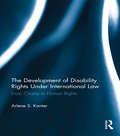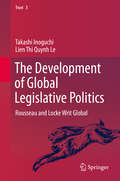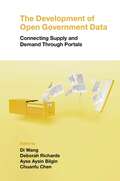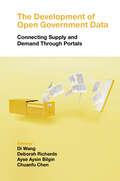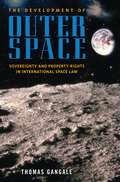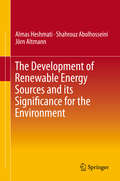- Table View
- List View
The Development of Disability Rights Under International Law: From Charity to Human Rights
by Arlene S. KanterThe adoption of the Convention on the Rights of People with Disabilities (CPRD) by the United Nations in 2006 is the first comprehensive and binding treaty on the rights of people with disabilities. It establishes the right of people with disabilities to equality, dignity, autonomy, full participation, as well as the right to live in the community, and the right to supported decision-making and inclusive education. Prior to the CRPD, international law had provided only limited protections to people with disabilities. This book analyses the development of disability rights as an international human rights movement. Focusing on the United States and countries in Asia, Africa, the Middle East the book examines the status of people with disabilities under international law prior to the adoption of the CPRD, and follows the development of human rights protections through the convention’s drafting process. Arlene Kanter argues that by including both new applications and entirely new approaches to human rights treaty enforcement, the CRPD is significant not only to people with disabilities but also to the general development of international human rights, by offering new human rights protections for all people. Taking a comparative perspective, the book explores how the success of the CRPD in achieving protections depends on the extent to which individual countries enforce domestic laws and policies, and the changing public attitudes towards people with disabilities. This book will be of excellent use and interest to researchers and students of human rights law, discrimination, and disability studies.
The Development of Disability Rights Under International Law: From Charity to Human Rights
by Arlene S. KanterThe adoption of the Convention on the Rights of People with Disabilities (CPRD) by the United Nations in 2006 is the first comprehensive and binding treaty on the rights of people with disabilities. It establishes the right of people with disabilities to equality, dignity, autonomy, full participation, as well as the right to live in the community, and the right to supported decision-making and inclusive education. Prior to the CRPD, international law had provided only limited protections to people with disabilities. This book analyses the development of disability rights as an international human rights movement. Focusing on the United States and countries in Asia, Africa, the Middle East the book examines the status of people with disabilities under international law prior to the adoption of the CPRD, and follows the development of human rights protections through the convention’s drafting process. Arlene Kanter argues that by including both new applications and entirely new approaches to human rights treaty enforcement, the CRPD is significant not only to people with disabilities but also to the general development of international human rights, by offering new human rights protections for all people. Taking a comparative perspective, the book explores how the success of the CRPD in achieving protections depends on the extent to which individual countries enforce domestic laws and policies, and the changing public attitudes towards people with disabilities. This book will be of excellent use and interest to researchers and students of human rights law, discrimination, and disability studies.
The Development of E-governance in China: Improving Cybersecurity and Promoting Informatization as Means for Modernizing State Governance (Research Series on the Chinese Dream and China’s Development Path)
by Ping Du Shiyang Yu Daoling YangThis book figures out that network security and informatization have entered a development stage of greater permeation and deeper integration into all aspects of the economy and society. In particular since the 2008 financial crisis, the world’s major economies have placed a strategic focus on network security and informatization in order to seek out new growth points, alleviate energy and ecological pressures, improve living standards, and improve social governance through new technological transformations in fields such as cloud computing, the Internet of Things, mobile internet, big data, smart cities, and a wave of applications. The effects on the economy and society have emerged and will continue to make significant progress. Based on China’s stage of new urbanization, industrialization, informatization, and agricultural modernization and major characteristics, as well as the intrinsic need for synchronized development, this book encourages society to accelerate the pace of development, expand the scope of work and promote informatization and the comprehensive, coordinated, effective linking and deep integration of informatization with all areas of the economy and society.
The Development of Early Childhood Education in Europe and North America: Historical and Comparative Perspectives
by Kristen Nawrotzki Harry Willekens Kirsten ScheiweThe public provision of early childhood education has developed at different rates across individual countries over the past two centuries. This book provides the historical background to explain how these national differences occurred, with particular reference to welfare and educational systems, to highlight how particular influences grew.
The Development of Equity Capital Markets in Transition Economies: Privatisation and Shareholder Rights (Contributions to Economics)
by Dirk WillerThis book addresses two different but related topics that can arise during the development of equity capital markets and which could possibly hinder their development: partial privatisation and shareholder rights. Both issues are developed in the context of transition economies in general and Russia in particular. Chapter 2 puts forward a theory of partial privatisation, i. e. a model that aims to explain why the state keeps some residual shares. Several recent surveys for Russia have shown that the state does often not actively use the voting rights of its residual shares. If this was true, partial privati sation could entrench management and hinder restructuring. It would also limit the supply of shares, which could lead to low liquidity. This would be likely to slow down the development of the equity capital market. However, the model in chapter 2 shows that it can be rational to hold back shares from sale in order to maximise privatisation receipts. Another issue which holds back the development of this market is the fact that shareholder rights can not be guaranteed by the state due to weak institutions. Chapter 3 contains an empirical examination of which firms honour shareholder rights and also provides a direct link between this problem and partial privatisation. Maybe surprisingly, some weak evidence is presented that shows that the residual state holding does not exert a negative influence with respect to the introduc tion of shareholder rights, but might even be a weak positive force.
The Development of European Competition Policy: Social Democracy and Regulation (Routledge Explorations in Economic History)
by Sigfrido M. Ramírez Pérez Brian ShaevThis book considers a central issue of our time: the relationship between the macroeconomic objectives of political parties in democratic countries and the legal framework of market economies. The impressive panel of contributors examines social-democratic policies on cartels, market concentration and competition in different European countries, spanning a hundred-year period (specifically the interwar period, the initial postwar period, the 1960s and 1970s, the 1980s and 1990s, and the 2000s).This thought-provoking volume challenges the dominant belief that the EU’s economic system and competition policy were mainly influenced by neoliberal economic thinking, instead showing that Keynesian and social-democratic positions played a major role in the emergence of this system.It will be valuable reading for advanced students, researchers and policymakers interested in modern economic history, industrial organization, political economy, European legal history and political science.
The Development of European Competition Policy: Social Democracy and Regulation (Routledge Explorations in Economic History)
This book considers a central issue of our time: the relationship between the macroeconomic objectives of political parties in democratic countries and the legal framework of market economies. The impressive panel of contributors examines social-democratic policies on cartels, market concentration and competition in different European countries, spanning a hundred-year period (specifically the interwar period, the initial postwar period, the 1960s and 1970s, the 1980s and 1990s, and the 2000s).This thought-provoking volume challenges the dominant belief that the EU’s economic system and competition policy were mainly influenced by neoliberal economic thinking, instead showing that Keynesian and social-democratic positions played a major role in the emergence of this system.It will be valuable reading for advanced students, researchers and policymakers interested in modern economic history, industrial organization, political economy, European legal history and political science.
The Development of Global Legislative Politics: Rousseau and Locke Writ Global (Trust #3)
by Takashi Inoguchi Lien Thi LeThis book is the first systematic scientific study of global quasi-legislation. Taking public opinion and multilateral agreements as the international equivalent to national election and passing laws on the national scale, and extending nation-state concepts to a global society, it analyzes citizens' preferences and the state's willingness to enter into 120 multilateral treaties. After identifying the links as a first step toward conceptualizing quasi-legislative global politics, the book examines how each of the 193 states manifests quasi-legislative behavior by factor-analyzing six instrumental variables such as treaty participation index and six policy domains of multilateral treaties, including peace and trade. It then discusses global change between 1989 and 2008, and conceptually and empirically examines the three theories of global politics that originated during that period: the theory of power transition, theory of civilizational clash and theory of global legislative politics. Lastly, it proposes a theory of global legislative politics. Shedding fresh light on the transformative nature of multilateral treaties, this book attracts researchers and students in political philosophy, international law and international relations as well as practitioners and journalists.Inoguchi and Le have developed a genuinely original perspective on world politics, one that opens up a new research agenda for thinking about state and global actors simultaneously.-- Anne-Marie Slaughter, Bert G. Kerstetter '66 University Professor Emerita of Politics and International Affairs, Princeton UniversityThis is one of those books that warrant a global readership given its emphasis on the implied trust that we invest in public institutions as viewed from an interdisciplinary perspective. -- Richard J. Estes, Professor of Social Policy & Practice, University of Pennsylvania, Philadelphia, PennsylvaniaThis book is innovative and distinctive in carving out a new way to look at “global legislative politics.” I do not know of anything that compares in this interesting and novel niche of international relations analysis.-- William R. Thompson, Distinguished Professor and Rogers Chair of Political Science Emeritus, Indiana University
The Development of Institutions of Human Rights: A Comparative Study (Perspectives in Comparative Politics)
by Lilian A. Barria & Steven D. RoperDuring the transition to democracy, states have used various mechanisms to address previous human rights abuses including trials, truth and reconciliation commissions and internationalized tribunals. This volume analyzes the transitional justice choices made by four countries: Argentina, Bosnia-Herzegovina (BiH), Sierra Leone and East Timor.
The Development of International Human Rights Law: Volume I
by David WeissbrodtThe essays selected for this volume, written by some of the worlds most respected experts on human rights, encompass the development of human rights law from its philosophical underpinnings and address many of its current controversies. The collected essays explore the drafting of major human rights instruments, including the political challenges that shaped those instruments; examine the interrelationship of various claimed rights; and identify factors producing compliance with - and violation of - human rights law. Other contributions analyze the role of non-governmental organizations in achieving better human rights protections as well as the danger of claiming too many rights, and the tension between rights and security. Contrasting viewpoints in several essays highlight some of the key conflicts in the field. An introductory essay provides a roadmap marking the collection‘s major themes, and tracing the relationship between those themes. Taken together, the essays emphasize the legal underpinnings of the human rights regime and as such, the collection provides an essential, wide-ranging account of this important part of international law, procedure and practice.
The Development of International Human Rights Law: Volume I
by WeissbrodtD. Ní AoláinRumsey DavidFionnualaMaryThe essays selected for this volume, written by some of the worlds most respected experts on human rights, encompass the development of human rights law from its philosophical underpinnings and address many of its current controversies. The collected essays explore the drafting of major human rights instruments, including the political challenges that shaped those instruments; examine the interrelationship of various claimed rights; and identify factors producing compliance with - and violation of - human rights law. Other contributions analyze the role of non-governmental organizations in achieving better human rights protections as well as the danger of claiming too many rights, and the tension between rights and security. Contrasting viewpoints in several essays highlight some of the key conflicts in the field. An introductory essay provides a roadmap marking the collection‘s major themes, and tracing the relationship between those themes. Taken together, the essays emphasize the legal underpinnings of the human rights regime and as such, the collection provides an essential, wide-ranging account of this important part of international law, procedure and practice.
The Development of Local Government (Routledge Revivals)
by William A. RobsonFirst Published in 1931, The Development of Local Government presents a comprehensive account of the most important questions related to various aspects of local government. William A. Robson gives us an illuminating history and survey of facts about crucial themes like the municipal structure; the function of local authorities; public health administration; the danger of centralization; conflict of town and country; expansion of cities; need for reconstruction; cultural aspects of civic life; and employment of women in the municipal service. This book is a must read for students and researchers of public administration, political studies, and governance studies.
The Development of Local Government (Routledge Revivals)
by William A. RobsonFirst Published in 1931, The Development of Local Government presents a comprehensive account of the most important questions related to various aspects of local government. William A. Robson gives us an illuminating history and survey of facts about crucial themes like the municipal structure; the function of local authorities; public health administration; the danger of centralization; conflict of town and country; expansion of cities; need for reconstruction; cultural aspects of civic life; and employment of women in the municipal service. This book is a must read for students and researchers of public administration, political studies, and governance studies.
The Development of Nuclear Propulsion in the Royal Navy, 1946-1975 (Security, Conflict and Cooperation in the Contemporary World)
by Gareth Michael JonesThis book examines the development of nuclear propulsion in the Royal Navy from the first proposal in 1946 to the start-up of the last core improvement for the first submarine reactor power plant PWR 1 in December 1974. Drawing from unreleased records and archives, the book answers questions around three main themes. Political: what problems were encountered in transferring nuclear knowledge from the USA to the UK in the post-war period, and how much support was there for the development of nuclear propulsion? Military: why was there a requirement to develop nuclear propulsion, and in particular, why submarines? Technical: were the problems associated with nuclear energy fully appreciated, and did the UK have the technical and engineering capability to develop nuclear propulsion? Aside from the political considerations and military motives for developing nuclear propulsion in the Royal Navy, the author focuses on the technical problems that had to be overcome by all participants in the Royal Navy’s development of nuclear propulsion, adding significantly to naval historiography. Providing a critical analysis of the political, technological, operational and industrial issues of introducing nuclear propulsion into the Royal Navy, the author situates his research in the context of the evolving Cold War, changing Anglo-American relations, the end of Empire and the relative decline of British power.
The Development of Open Government Data: Connecting Supply and Demand Through Portals
by Di Wang Deborah Richards Ayse Aysin Bilgin Chuanfu ChenOpen government data (OGD) has developed rapidly in recent years due to various benefits that can be derived through transparency and public access. However, researchers emphasize a lack of use instead of lack of disclosure as a key problem in OGD’s present development. Previous studies have approached this issue either from the supply-side, focusing on data quantity and quality, or from the demand-side, focusing on factors that affect users’ acceptance of OGD, but seldom consider both sides at the same time. This unique study compares the supply and demand sides of OGD and explores possible directions for the future development of OGD portals based on the discovered mismatches between the two. The authors improve OGD utilization by balancing the supply-side and demand-side according to citizens’ demands through OGD portals. Based on the concept of an OGD ecosystem, four connected studies are explored. The first study built an evaluation framework for understanding the development of the OGD supply-side. The second study focuses on a survey conducted to analyze the awareness and utilization of OGD portals by citizens, who are the primary users and major beneficiaries of OGD on the demand-side. A third study compares the supply and demand sides based on Diffusion of Innovation theory. A final study tests the proposed usability criteria for building an OGD portal by carrying out a between-subjects experiment including a virtual agent. Each case study examines a unique aspect of OGD in China, and also offers reflections on future directions for developing OGD. Providing a unique and enhanced theoretical and practical understanding of OGD and its usage, as well as proposing directions for OGD portals’ future development in order to encourage citizens’ OGD utilization, this is a must-read for researchers and policymakers examining the impact and possibilities of OGD.
The Development of Open Government Data: Connecting Supply and Demand Through Portals
by Di Wang Deborah Richards Ayse Aysin Bilgin Chuanfu ChenOpen government data (OGD) has developed rapidly in recent years due to various benefits that can be derived through transparency and public access. However, researchers emphasize a lack of use instead of lack of disclosure as a key problem in OGD’s present development. Previous studies have approached this issue either from the supply-side, focusing on data quantity and quality, or from the demand-side, focusing on factors that affect users’ acceptance of OGD, but seldom consider both sides at the same time. This unique study compares the supply and demand sides of OGD and explores possible directions for the future development of OGD portals based on the discovered mismatches between the two. The authors improve OGD utilization by balancing the supply-side and demand-side according to citizens’ demands through OGD portals. Based on the concept of an OGD ecosystem, four connected studies are explored. The first study built an evaluation framework for understanding the development of the OGD supply-side. The second study focuses on a survey conducted to analyze the awareness and utilization of OGD portals by citizens, who are the primary users and major beneficiaries of OGD on the demand-side. A third study compares the supply and demand sides based on Diffusion of Innovation theory. A final study tests the proposed usability criteria for building an OGD portal by carrying out a between-subjects experiment including a virtual agent. Each case study examines a unique aspect of OGD in China, and also offers reflections on future directions for developing OGD. Providing a unique and enhanced theoretical and practical understanding of OGD and its usage, as well as proposing directions for OGD portals’ future development in order to encourage citizens’ OGD utilization, this is a must-read for researchers and policymakers examining the impact and possibilities of OGD.
The Development of Outer Space: Sovereignty and Property Rights in International Space Law (Non-ser.)
by Thomas GangaleThis account of the evolution of outer space law examines key issues that fuel the debates over sovereignty and property rights designed to govern the future colonization and use of heavenly bodies other than our own.In the United States, lobbies for the commercial development of space have become increasingly antagonistic toward the international legal regime of outer space, condemning the 1967 Outer Space Treaty and the unratified 1979 Moon Agreement as anti-business. The Development of Outer Space: Sovereignty and Property Rights in International Space Law argues that the res communis principle enshrined in the Outer Space Treaty was misrepresented here, with essential help from corporate lobbyists whose real object was the defeat of the Law of the Sea Convention. Thomas Gangale builds the legal case for reviving the moribund Moon Agreement as a prelude to negotiating a second Moon treaty to establish a regulatory regime for the exploitation of extraterrestrial resources.The author's account of the inception and evolution of outer space law to date is deeply informed by his appreciation of such terrestrial considerations as the nation-state system, the contending economic theories of capitalism and communism, and the post-colonial struggle between the developed space-faring nations and the developing earthbound nations.
The Development of Radar Equipments for the Royal Navy, 1935–45
by F. A. KingsleyThis book presents authoritative accounts of the evolution, development and application of Royal Naval radar from its inception in 1935 until the end of World War 2. The accounts are based on the individual authors' contemporary experiences, extensive archival research and discussions with surviving wartime colleagues. An overview is presented of the pioneering work at HM Signal School (later the Admiralty Signal Establishment), followed by descriptions of the main programmes of radar development, associated research, and the problems of installation of the equipment in ships, as well as its operation and maintenance at sea. Tabulations of the characteristics and installations of all wartime Royal Naval radars are provided in the Appendices.
The Development of Renewable Energy Sources and its Significance for the Environment
by Almas Heshmati Shahrouz Abolhosseini Jörn AltmannThis book analyzes the effects of power generated by renewable energy sources, renewable energy production technologies, energy efficiency, and market regulation of carbon emissions. It elaborates on how these parameters have direct and indirect effects on carbon emission reduction, such as the results of an environmental tax that could directly reduce carbon emissions by decreasing fossil fuel consumption or by stimulating energy savings through technological innovation, as well as how renewable energy sources can affect both economic growth and the environment. In addition to a detailed analysis of the interrelationships between renewable energy consumption, production technology, and market regulation, The Development of Renewable Energy Sources and its Significance for the Environment proposes a model for measuring the effectiveness and results of the interaction between these links. Furthermore, a structure for a marketplace of renewable energy sources is put forward, as well as an outline of the requirements that must be met in order for this market to function. Suitable policy recommendations to enhance the market for renewable energies are also provided.
The Development of Saudi-Iranian Relations since the 1990s: Between conflict and accommodation
by Fahad M. Alsultan Pedram SaeidSaudi Arabia and Iran have established themselves as the two regional heavyweights in one of the world’s most tumultuous but critically significant regions. The two countries compete on many fronts, including regional politics, oil prices, and for leadership of the Islamic world, a competition with undeniable repercussions for the Greater Middle East and for the world. Some observers have gone so far as to claim that virtually everything that happens in this area of the world can be viewed as part of the Saudi-Iranian power struggle. With increasing importance of the region as the dominant supplier of world energy and the birthplace of Islamic militant groups, the consequences of not understanding Saudi-Iranian rivalry in the region have never been more serious. A range of internal and external explanatory factors explains the ups and downs of Saudi-Iranian relations since the 1990s. This book captures this complexity by drawing on multicausal explanations through multiple levels of interdisciplinary analysis. This is the first book on the subject that is co-authored by one author from Saudi Arabia and one from Iran. This collaboration allowed the authors to make the best use of Persian and Arabic sources, generating a locally meaningful account of the two countries’ relationship. As Iranian and Saudi nationals, they encountered less difficulty in gaining access to research participants, building rapport and conducting interviews with Iranian and Saudi scholars and informants.
The Development of Saudi-Iranian Relations since the 1990s: Between conflict and accommodation
by Fahad M. Alsultan Pedram SaeidSaudi Arabia and Iran have established themselves as the two regional heavyweights in one of the world’s most tumultuous but critically significant regions. The two countries compete on many fronts, including regional politics, oil prices, and for leadership of the Islamic world, a competition with undeniable repercussions for the Greater Middle East and for the world. Some observers have gone so far as to claim that virtually everything that happens in this area of the world can be viewed as part of the Saudi-Iranian power struggle. With increasing importance of the region as the dominant supplier of world energy and the birthplace of Islamic militant groups, the consequences of not understanding Saudi-Iranian rivalry in the region have never been more serious. A range of internal and external explanatory factors explains the ups and downs of Saudi-Iranian relations since the 1990s. This book captures this complexity by drawing on multicausal explanations through multiple levels of interdisciplinary analysis. This is the first book on the subject that is co-authored by one author from Saudi Arabia and one from Iran. This collaboration allowed the authors to make the best use of Persian and Arabic sources, generating a locally meaningful account of the two countries’ relationship. As Iranian and Saudi nationals, they encountered less difficulty in gaining access to research participants, building rapport and conducting interviews with Iranian and Saudi scholars and informants.
The Development of Science and Technology in Iran: Policies and Learning Frameworks
by Abdol S. Soofi Mehdi GoodarziThis book examines the policies, conducts, and performances of organizations tasked with developing medium and high technologies in Iran. This collection assists readers in understanding the interaction between different players involve in the process of Iran’s science, technology, and innovation development in specific technology areas over the last two decades. Chapters from expert contributors are organized into three themed parts: science and technology policy formulation and implementation, outcomes, and evaluation, including recommendations for further development of technological learning in Iran.
The Development of Secularism in Turkey
by Niyazi BerkesFirst Published in 1999. Routledge is an imprint of Taylor & Francis, an informa company.
The Development of Secularism in Turkey
by Niyazi BerkesFirst Published in 1999. Routledge is an imprint of Taylor & Francis, an informa company.
The Development of Service Economy: A General Trend of the Changing Economy in China
by Zhenhua ZhouThis book focuses on service economy development, particularly on how an industrial economy evolves into a service economy. The book is organized in three sections: The first theoretically answers the general question "what is the service economy?” The second explains the mechanism of the service economy’s formation and development, revealing the evolution trends and attempts to answer the question “where does the service economy come from?" The third section includes an in-depth analysis of Chinese case studies to answer the key question "how can the service economy development be promoted?" Readers will discover what the service economy is and how it relates to and differs from the industrial economy. More importantly, it will provide policy-makers with suggestions for how to promote service-economy development.
